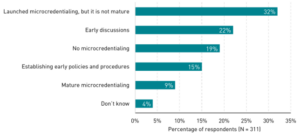Would you use a pitchfork to find a needle in a haystack?
It’s a question that Noah Geisel, the micro-credential program manager at the University of Colorado Boulder, asks employers, admissions counselors and all other professionals trying to find the most qualified human among the swaths of faceless applicants—the hay. Currently, too many industry stakeholders are too dependent on the pitchfork, according to Geisel.
“It’s a crummy tool,” he quips. Pitchforks stab chunks of hay and toss it around to search for the needle, adding to the chaos and confounding the seeker. One would be better off using a high-powered magnet to attract the needle to them rather than attempting to cut the hay out of the way.
Digital credentials and the machine-readable devices that can authenticate them, Geisel believes, are precisely that tool.
He joins a budding cohort of higher education professionals, industry leaders and state legislators who recognize its revelatory potential to foster the next chapter of academic equity, workforce access and attractive program offerings in higher ed.
What exactly are digital credentials, and what are they good for?
Micro-credentials, alternative credentials, stackable credentials—the list goes on, creating a jargon soup many leaders are hesitant to touch.
“It is confusing. Academic microcredentials, nonacademic microcredentials. There are still many moving parts,” said one higher education leader, according to EDUCASUE’s QuickPoll survey on micro-credential trends.
What’s important is how digital credentials umbrella all these programs to provide admissions counselors and employers a nuanced, insightful snapshot of an applicant’s specific skillsets. Geisel says it best: A micro-credential is to a digital credential, what a degree is to a diploma. And combining a diploma and digital credentials creates a textured picture.
“Digital credentials can contextualize formal recognition of achievement, skills, competencies and experiences. A diploma just has a name on it. If a diploma is issued with digital credential technology, we can contextualize it to turn it in from this flat piece of paper to this 360-degree, high-definition narrative,” says Geisel. “It takes on a storytelling capacity to better communicate who this person is as a learner and achiever.”
The key to developing a meaningful digital credential is that it communicates a specific value, much like a currency does. If it’s not specific, then it’s frivolous.
“On one hand, it can be so granular as to lose meaningfulness, but on the other end, where you aren’t specific, you can also lose meaning,” says Geisel. “What if we issued a badge on DEI?” Geisel says. “At best, the most reliable signal there is a hiring manager knows you’re interested in it, you know? It’s such a broad thing to have a credential called DEI because it’s lacking in granularity.”
While a DEI credential may be too broad, Geisel adds, one highlighting the specific competencies learned within the DEI curriculum is on the right track. Here’s a good example for one: sustainability planning for business. That’s a credential Geisel is currently issuing at CU Boulder.
For beginners in the digital credential space, the most important aspect to focus on is not its taxonomy. It should be on whether it is effectively communicating something of concrete value and contextualizing the person behind the credential.
Digital credentials’ great potential
Certificates and special non-degree credentials were the only programs to experience positive enrollment rates across every sector of higher education this past spring semester, according to the National Student Clearinghouse Research Center. Private for-profit and 2-year institutions were the only sectors of higher education to increase enrollment, and it’s a direct result of their impressive non-degree enrollment rates.
In the workforce, a February report found that 95% of employers said a résumé listing micro-credentials benefited the candidate because it demonstrates a willingness for skill development (76%).
“Everybody’s talking about micro-credentials, even those campuses that a year or two ago were saying they weren’t. They’re changing their tune,” says Kristi Wold-McCormick, assistant vice provost and University Registrar at CU Boulder and president-elect of the American Association of Collegiate Registrars and Admissions Officers (AACRAO). “The ‘why’ is a big question when we talk to different campuses.”
Wold-McCormick finds that institutions are incentivized by their potential to broaden their reach, diversify revenue streams, and competitive pressure from other institutions beginning their programs. Legislatures, too, are driving the movement, as they’re interested in seeing how schools can turn some of these learning opportunities into stackable credentials.
“How can some of these micro-credentials be stacked into certificates, and how can certificates be stacked into degrees?” says Wold-McCormick. “It’s incremental learning, which I think appeals to populations that haven’t historically had a path to traditional education.”
Wold-McCormick and other academic leaders are realizing that micro-credentials can tap a new range of students that have traditionally been boxed out of higher education. While online learning has been the predominant medium for the working class to attain a degree, nearly half have not completed their last program of study. Similarly, Black and Hispanic adults interested in pursuing higher education but are not enrolled are significantly more responsible for caring for a child or family member than white adults.
“They can be used to help get people into higher education streams that traditionally don’t have that access by giving them opportunities to take a course or two in smaller credentials,” says Wold-McCormick. “It can then give them that roadmap on how to use these credentials to inform larger credentials and keep that interest going once they’ve gotten a taste for it.”
Despite the direct interest from students and employers in micro-credentials, most colleges and universities are behind the eight ball. Only 9% of institutions have a mature micro-credential program, according to EDUCAUSE. Another 32% say they have a program that is not yet mature.

Standardizing together
As colleges and universities develop their programs, Wold-McCormick cautions higher education stakeholders of the dangers of developing digital credentials in silos.
“What we don’t want are different types of guidance and standardizations and reports coming out from all these different associations that might not be aligned,” she says. “What we need to do as a higher ed community is get on the same page regarding definitions and standards.”
And as passionate as Geisel is about digital credentials’ ability to open the doors for new student demographics, he urges stakeholders to be intentional, vigilant even, to ensure those voices are in the room developing it as well.
“There’s so much power in deciding what counts because we are also deciding at that moment what doesn’t make the cut,” Geisel says. “When we’re looking around the room and realizing that for all of our talk and intentions and passion for serving learners who do not look like the learners who have historically been served well by our institutions. If we’re not seeing those people represented in the room, I think that’s a huge opportunity for us to pump the brakes.”









